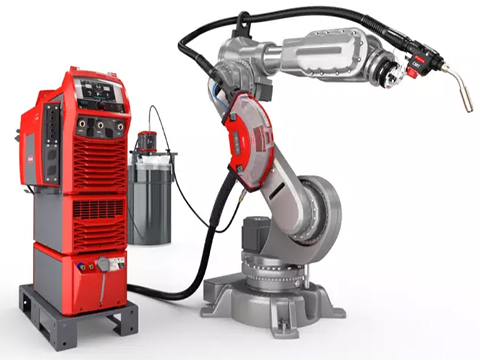
Posted to News on 18th Sep 2024, 09:00
Metal 3D printing perfected in one welding characteristic
Using additive manufacturing, components, spare parts, and even prototypes can be manufactured in a way that's flexible, resource-efficient and profitable. The required components can be produced quickly and from virtually nothing, regardless of the location. With CMT Additive Pro, Fronius presents a 3D-optimised welding process with features such as an especially even layer structure, as well as high quality and stability.

On request, Fronius is also happy to use its welding expertise to provide tailored support. At the company's prototyping centre, component geometries that may have once seemed impossible are made into a reality, layer by layer.
Metal 3D printing is on the rise in many industries including automotive, oil and gas, aerospace engineering, ship and train building, and the manufacture of construction equipment and tools. Compared to conventional production processes, such as casting, machining, or milling, here the requirements in terms of moulds and materials are low. This process saves a lot of time and material, and provides enormous flexibility when designing and adapting different components.
More competitive and more flexible
Additive manufacturing has enormous potential, especially where the degree of individualisation is high. Today, unique metal components can be printed in highly complicated geometries that have previously been difficult or even impossible to achieve. One example of this is rapid prototyping, which allows manufacturers to quickly adapt and refine their product designs before moving to mass production. Topology optimizations that could not be achieved using conventional methods are now possible.
Metal 3D printing also simplifies repairs and on-demand printing of spare parts. It allows components to be manufactured 'just in time', eliminating the need for storage and the costs associated with it. Companies who use this method become more competitive and can significantly shorten their development cycles, which is a great advantage in our turbulent and volatile times.
Reliable high-end welding technology
"The right welding path with the right welding parameters and processes is crucial for a good result in metal 3D printing," explains Philipp Roithinger, an expert in additive manufacturing at Fronius International. "However, this requires a high-performance welding system that precisely ensures the accuracy of the welding torch."
The new iWave Multiprocess Pro combined with the Fronius CMT Additive Pro characteristic is optimised for metal 3D printing. This perfectly adapted equipment is now available. This complete solution is compatible with common robot systems for additive manufacturing and opens up a whole host of possibilities.
With CMT (Cold Metal Transfer), Fronius has been offering a highly stable, easily controllable and comparatively cool welding process for decades. This is already the preferred method for 3D printing around the world. It therefore makes total sense that the Austrian innovation leader has now optimised CMT specifically for metal 3D printing and put all the know-how it has amassed into the development of Fronius CMT Additive Pro. The integrated arc-on rate stabiliser ensures a consistent wire speed, resulting in an even and predictable build-up of layers. This significantly improves the overall stability of the manufacturing process.
"Another innovation is the adjustable heat input, which ensures consistency in the height and width ratio of the bead, regardless of the current temperature of the base material or the previously welded layer. Weld layers usually become wider and flatter as the component heats up," explains Roithinger. "The power correction feature counteracts this, so that identical welds can be stacked on top of each other, layer after layer."
The start of the weld within the construction process is another important criterion for metal 3D printing. Welding errors or cambers in the area where the weld was started can affect the quality of the result. Fronius has the perfect solution to this with the Pulsed Hot Start function, which simultaneously achieves sufficient penetration and a constant layer height by starting welding within the pulsed arc. Here, the whole process is controlled automatically, so no extra settings are necessary.
The Fronius development team has added valuable features to CMT for optimal 3D printing results, and combined everything in one characteristic. And the team of experts at the Fronius prototyping centre are on hand to come up with even more solutions for demanding welding challenges.
From the feasibility study to the pilot series
In its prototyping centre, Fronius provides a comprehensive service package. Here, tailor-made solutions are developed for individual requirements and customers' additive manufacturing processes are optimised, or highly complex components are realized. From the initial consultation and feasibility check to the development and manufacturing of parts, everything is carried out in close coordination with the client, and with the highest degree of discretion. The aim is to minimise the time-to-market and fully utilise the potential of innovation and technology in the projects.
The experts support the production of the initial prototypes and pre-series and enable a smooth entry into the additive manufacturing process. In addition, you will receive valid recommendations on the welding process, profitability, quality and implementation options, or the costs for the prototype and the start of production. The 900 m2 prototyping centre in Wels, Austria, has several isolated robot cells and systems, and offers full service, including offline programming and simulations, metallurgical investigations, 3D component measurement, complete data documentation and much more.





